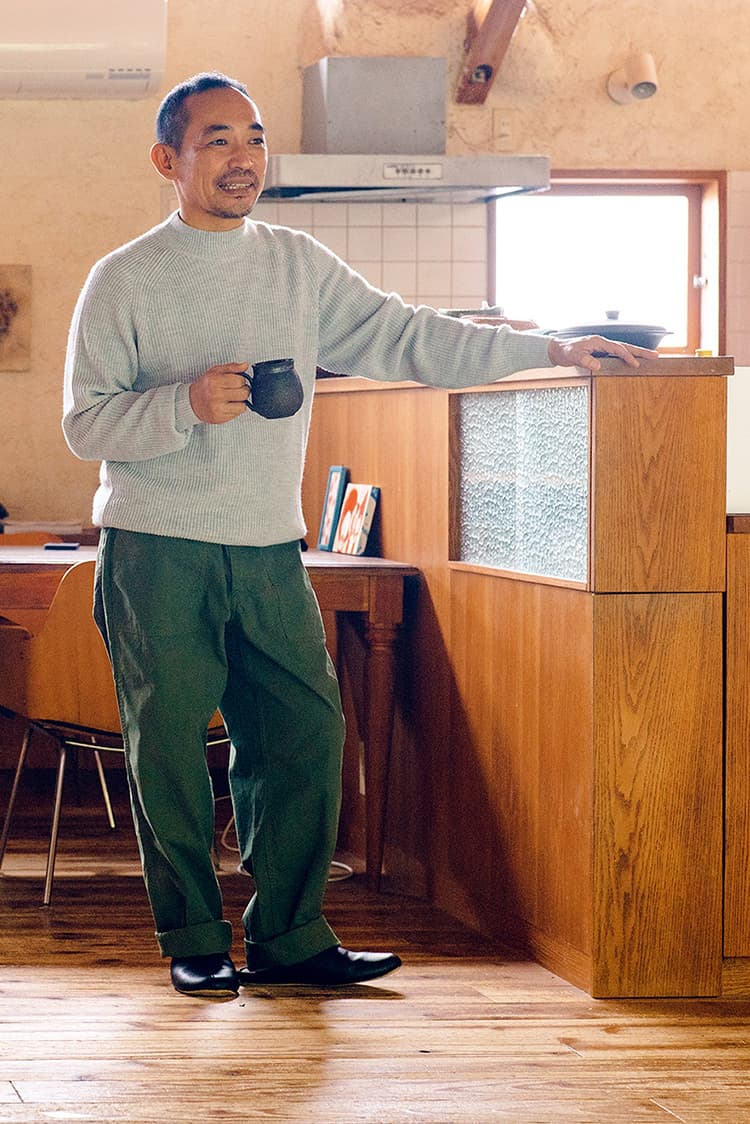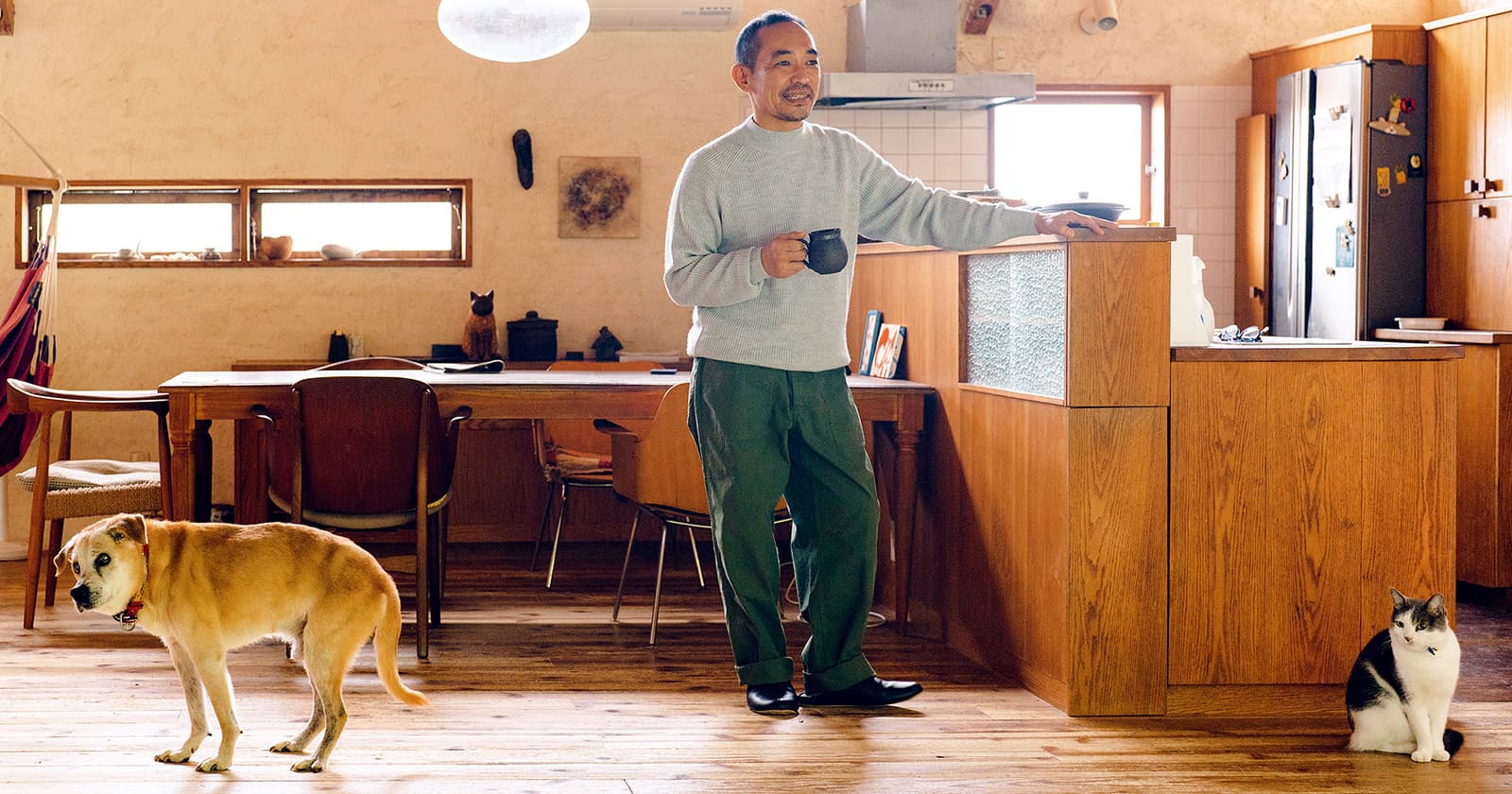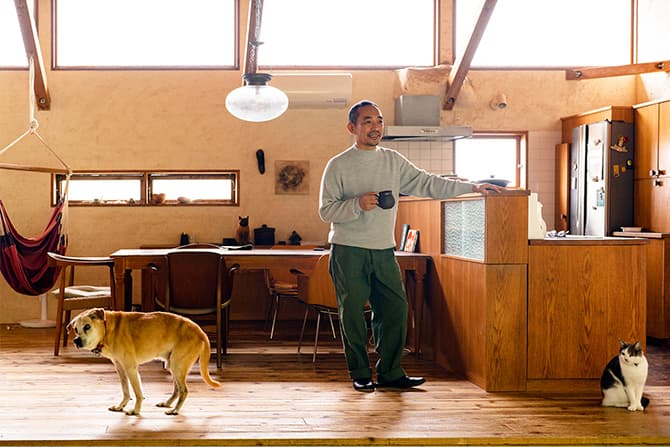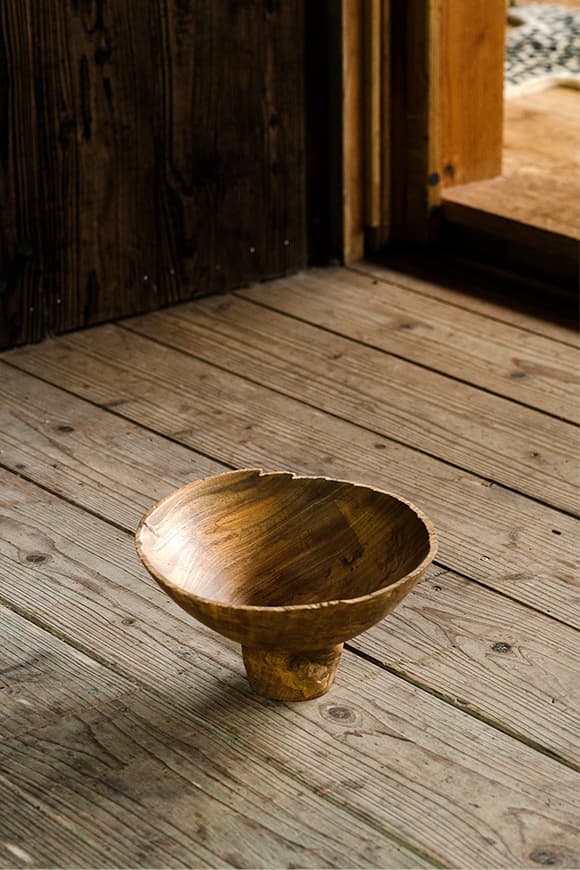People and LifeWear
- Photography by Kazufumi Shimoyashiki
- Text by Keisuke Kagiwada
- Special thanks to Natsuki Akiyama
These two fascinating artisans spend their days making crafts from the graces of the natural world.
Craftman_2
Ken Fujimoto
Woodworker
Born in 1971 in Aichi Prefecture. After moving to Tokyo, Fujimoto began woodworking in his mid-twenties, with a focus on furniture. In 2002, he left the city for Okinawa. For a time, he made furniture and other items on commission. In 2011, Fujimoto began using a lathe to turn vessels. He has shown his work at solo exhibitions ever since.
http://www.yakabu123.com/k/



About thirty minutes by car from Kokusai St. and only slightly inland from the breathtaking ocean views of Highway 331, you’ll find Tamagusuku, a village in the city of Nanjo, surrounded by vast fields of sugarcane. Ken Fujimoto, who lives and works in these lush environs, is a wood artisan specialising in vessels using Okinawan woods like gajumaru and akagi. Born in Aichi Prefecture, Fujimoto made furniture in Tokyo before relocating to Okinawa about twenty years ago. What brought him here initially was his partner Miho’s work.
“I have no personal roots in Okinawa. But we’d visited Ishigaki Island several times and loved it, so when my wife was transferred to Okinawa, I said ‘Let’s go’ without a thought. Hah! At the time, I never would have dreamed I’d wind up making works of art from Okinawan lumber. For our first ten years on the island, I did nothing but furniture commissions.”
Initially they lived in a more developed area, but twelve years ago Fujimoto and his wife moved to a plot of land in this green village. This charming wooden home and studio were designed and planned by Fujimoto singlehandedly. A woodworker is one thing, but a craftsman who designs entire buildings?
“The rules of furniture are detailed and precise. No gaps, no bulges or twists allowed. Home design, however, is a bit more loose in that respect. If you wind up with a little gap, you can just cover it with something, right?”
This sense of liberation stayed with Fujimoto, prompting him to shift gears and engage with wood as an artistic medium. But what really gave him steady footing was purchasing a wood lathe, something he had wanted for a long time.
“You can make furniture your whole life and never use a lathe. I’d never touched one myself. But once I got going, I couldn’t stop. It was so fun. For the first year and a half I kept taking furniture commissions while I did my lathework, but now that’s all I do. Okinawa doesn’t have great access to the wood you need for furniture making. If that wasn’t stressful enough, furniture involves a lot of prep work, meeting with clients and creating a design...all before you make the first cut. For the work I’m doing now, I get to discover the shape of the vessel as I go. This way of doing things is more my speed.”
 3
3And so Fujimoto began anew as a wood artisan, but the idea to use Okinawan woods was not part of his plan from the start. How did that come about?
“If you head over to the lumber yard, they really only have milled planks, barely thick enough to carve a plate. If you want to make a proper vessel, you need a big hunk of wood, basically a section of a tree. Trouble is, shipping that sort of wood is prohibitively expensive, when you’re living on an island. That’s how I started using Okinawan wood. It’s right here, all around us. In that sense, it was entirely unplanned, but when I tried it out, I found the wood has lots of personality. It’s a joy to work with. Gajumaru stands out for its grain and overall feel, while akagi has a signature colour and wonkiness. The wood I use is scrap, felled for lumber but tossed aside before it makes it to the mill. Craftsmen have overlooked this wood for ages, but it has an expressiveness that’s worthy of attention.”
Made entirely of greenwood, Fujimoto’s vessels have expressive features like warped grain and cracks, which mills would normally call “defects,” giving each one-of-a-kind work a primitive feel. Herein lies another twist of fate that Fujimoto has converted into artistry.
“People work with greenwood in Europe and the US, but Japanese woodworking, whether it be lacquerware or what have you, tends to rely on kiln-dried stock. This means you can produce lots of items in the same pattern. The wood won’t warp as it dries out. But in my case, I can try to plan the whole thing out, but it will never go as planned. I enjoy having a dialogue with the wood, figuring out the shape as we go along. It’s fun. That’s why greenwood is for me.”
In the words of Auguste Rodin, best known as the sculptor of The Thinker, “The artist is the confidant of nature, flowers carry on a dialogue with him through the graceful bending of their stems and the harmoniously tinted nuances of their blossoms. Every flower has a cordial word which nature directs towards him.” Like a confidant of nature, Fujimoto listens to the story of each and every tree as he creates his vessels.
 1
1 2
21. Fujimoto, working with his wood lathe. Each work is carved within an hour’s time. 2. Fujimoto loves to work in UNIQLO chinos. He wears a pair until they tear, then buys some more.
And so Fujimoto began anew as a wood artisan, but the idea to use Okinawan woods was not part of his plan from the start. How did that come about?
“If you head over to the lumber yard, they really only have milled planks, barely thick enough to carve a plate. If you want to make a proper vessel, you need a big hunk of wood, basically a section of a tree. Trouble is, shipping that sort of wood is prohibitively expensive, when you’re living on an island. That’s how I started using Okinawan wood. It’s right here, all around us. In that sense, it was entirely unplanned, but when I tried it out, I found the wood has lots of personality. It’s a joy to work with. Gajumaru stands out for its grain and overall feel, while akagi has a signature colour and wonkiness. The wood I use is scrap, felled for lumber but tossed aside before it makes it to the mill. Craftsmen have overlooked this wood for ages, but it has an expressiveness that’s worthy of attention.”
Made entirely of greenwood, Fujimoto’s vessels have expressive features like warped grain and cracks, which mills would normally call “defects,” giving each one-of-a-kind work a primitive feel. Herein lies another twist of fate that Fujimoto has converted into artistry.
“People work with greenwood in Europe and the US, but Japanese woodworking, whether it be lacquerware or what have you, tends to rely on kiln-dried stock. This means you can produce lots of items in the same pattern. The wood won’t warp as it dries out. But in my case, I can try to plan the whole thing out, but it will never go as planned. I enjoy having a dialogue with the wood, figuring out the shape as we go along. It’s fun. That’s why greenwood is for me.”
 3
3 4
43. Works by Fujimoto. The gray item at bottom right, from his “Sabi Urushi” series, uses traditional Japanese lacquer in an innovative way. Prices start at ¥5,500.
4. Fujimoto sells most of his creations. This priceless bowl carved from Gajumaru, however, has stayed with him through a twist of fate.
In the words of Auguste Rodin, best known as the sculptor of The Thinker, “The artist is the confidant of nature, flowers carry on a dialogue with him through the graceful bending of their stems and the harmoniously tinted nuances of their blossoms. Every flower has a cordial word which nature directs towards him.” Like a confidant of nature, Fujimoto listens to the story of each and every tree as he creates his vessels.
“Akagi is a tree that radically deforms after it’s cut. With some pieces of wood, you only find a cavity after you’ve already done a bit of carving. I make an effort to leave room for these surprises, to work in a way that doesn’t put excessive emphasis on control. This is a whole other world from furniture, where all kinds of things need to be done just right. Living in Okinawa has been instrumental in helping me to let go of the rules and approach my work from a place of freedom. I’ve lived a pretty haphazard life, whether it’s coming to Okinawa or becoming a wood artisan. It’s all chance!”
“Akagi is a tree that radically deforms after it’s cut. With some pieces of wood, you only find a cavity after you’ve already done a bit of carving. I make an effort to leave room for these surprises, to work in a way that doesn’t put excessive emphasis on control. This is a whole other world from furniture, where all kinds of things need to be done just right. Living in Okinawa has been instrumental in helping me to let go of the rules and approach my work from a place of freedom. I’ve lived a pretty haphazard life, whether it’s coming to Okinawa or becoming a wood artisan. It’s all chance!”
In recent years, other artists have joined Fujimoto and set up studios in Tamagusuku, among a steadily increasing number of interesting shops. For his part, Fujimoto is something of a pillar of the community. He was the architect behind Ryori Ibukuro, an artsy bistro, and Basho no Ie, a rental cottage in the middle of a banana grove. With a friend, he also manages Tamagusuku Shokudo, a restaurant and gallery where guests can purchase work by local artists.
“I don’t have a specific plan or overarching vision. We just want the place we live to become an interesting place to be. The story behind Tamagusuku Shokudo is wild. You see, I’m part of a group called Tamatorakai, nine of us in total, ceramicists and artists. One day somebody contacts us and says, ‘There’s this community centre no one’s using. I like what you’ve been up to. Wanna be involved?’ After a year of planning, we opened doors in 2021. It’s crazy, considering Tamatorakai started as a way for a group of drinking buddies to share a truck! That’s how Ryori Ibukoro started, too. A chef I know told me they were thinking about starting a restaurant. I got excited and said, ‘Why not open up next door?’ People at town hall are really pumped about Tamagusuku Shokudo, though. I’m hoping we can partner with the local government and breathe more life into this area.”

In the garden in front of his studio. This is a healing space, alive with greenery.
What is Be.Okinawa?
Founded in 2013, Be.Okinawa is devoted to supporting local tourism. “Be” is about being present, prompting you to partake in an experience. This island is a place of beautiful nature and warm-hearted people, where you can be your true self. A place where travellers, whoever they might be, can soak up the fresh air, mingle with the locals, and connect from the heart.
https://beokinawa.jp/



